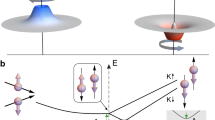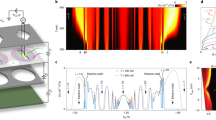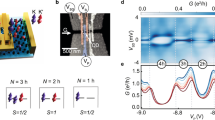Abstract
Particle–hole symmetry plays an important role in the characterization of topological phases in solid-state systems1. It is found, for example, in free-fermion systems at half filling and it is closely related to the notion of antiparticles in relativistic field theories2. In the low-energy limit, graphene is a prime example of a gapless particle–hole symmetric system described by an effective Dirac equation3,4 in which topological phases can be understood by studying ways to open a gap by preserving (or breaking) symmetries5,6. An important example is the intrinsic Kane–Mele spin-orbit gap of graphene, which leads to a lifting of the spin-valley degeneracy and renders graphene a topological insulator in a quantum spin Hall phase7 while preserving particle–hole symmetry. Here we show that bilayer graphene allows the realization of electron–hole double quantum dots that exhibit near-perfect particle–hole symmetry, in which transport occurs via the creation and annihilation of single electron–hole pairs with opposite quantum numbers. Moreover, we show that particle–hole symmetric spin and valley textures lead to a protected single-particle spin-valley blockade. The latter will allow robust spin-to-charge and valley-to-charge conversion, which are essential for the operation of spin and valley qubits.
This is a preview of subscription content, access via your institution
Access options
Access Nature and 54 other Nature Portfolio journals
Get Nature+, our best-value online-access subscription
$29.99 / 30 days
cancel any time
Subscribe to this journal
Receive 51 print issues and online access
$199.00 per year
only $3.90 per issue
Buy this article
- Purchase on Springer Link
- Instant access to full article PDF
Prices may be subject to local taxes which are calculated during checkout




Similar content being viewed by others
Data availability
The data supporting the findings are available in a Zenodo repository under accession code https://doi.org/10.5281/zenodo.7821944.
Code availability
The simulation code is available in a Zenodo repository under accession code https://doi.org/10.5281/zenodo.7821944
References
Zirnbauer, M. R. Particle-hole symmetries in condensed matter. J. Math. Phys. 62, 021101 (2021).
Maurice, D. P. A. A theory of electrons and protons. Proc. R. Soc. Lond. A Math. Phys. Sci. 126, 360–365 (1930).
McCann, E. & Koshino, M. The electronic properties of bilayer graphene. Rep. Prog. Phys. 76, 056503 (2013).
Castro Neto, A. H., Guinea, F., Peres, N. M. R., Novoselov, K. S. & Geim, A. K. The electronic properties of graphene. Rev. Mod. Phys. 81, 109–162 (2009).
Haldane, F. D. M. Model for a quantum Hall effect without Landau levels: condensed-matter realization of the “parity anomaly”. Phys. Rev. Lett. 61, 2015–2018 (1988).
Qi, X.-L. & Zhang, S.-C. Topological insulators and superconductors. Rev. Mod. Phys. 83, 1057–1110 (2011).
Kane, C. L. & Mele, E. J. Quantum spin Hall effect in graphene. Phys. Rev. Lett. 95, 226801 (2005).
Konschuh, S., Gmitra, M., Kochan, D. & Fabian, J. Theory of spin-orbit coupling in bilayer graphene. Phys. Rev. B 85, 115423 (2012).
Kurzmann, A. et al. Kondo effect and spin-orbit coupling in graphene quantum dots. Nat. Commun. 12, 6004 (2021).
Banszerus, L. et al. Spin-valley coupling in single-electron bilayer graphene quantum dots. Nat. Commun. 12, 5250 (2021).
Wojtaszek, M., Vera-Marun, I. J., Whiteway, E., Hilke, M. & van Wees, B. J. Absence of hyperfine effects in 13C-graphene spin-valve devices. Phys. Rev. B 89, 035417 (2014).
Fischer, J. & Loss, D. Dealing with decoherence. Science 324, 1277–1278 (2009).
Icking, E. et al. Transport spectroscopy of ultraclean tunable band gaps in bilayer graphene. Adv. Electron. Mater. 8, 2200510 (2022).
Eich, M. et al. Coupled quantum dots in bilayer graphene. Nano Lett. 18, 5042–5048 (2018).
Banszerus, L. et al. Electron-hole crossover in gate-controlled bilayer graphene quantum dots. Nano Lett. 20, 7709–7715 (2020).
Banszerus, L. et al. Gate-defined electron-hole double dots in bilayer graphene. Nano Lett. 18, 4785–4790 (2018).
Banszerus, L. et al. Single-electron double quantum dots in bilayer graphene. Nano Lett. 20, 2005–2011 (2020).
Tong, C. et al. Tunable valley splitting and bipolar operation in graphene quantum dots. Nano Lett. 21, 1068–1073 (2021).
Knothe, A. & Fal’ko, V. Influence of minivalleys and Berry curvature on electrostatically induced quantum wires in gapped bilayer graphene. Phys. Rev. B 98, 155435 (2018).
Laird, E. A. et al. Quantum transport in carbon nanotubes. Rev. Mod. Phys. 87, 703–764 (2015).
Banszerus, L. et al. Tunable interdot coupling in few-electron bilayer graphene double quantum dots. Appl. Phys. Lett. 118, 103101 (2021).
Banszerus, L. et al. Observation of the spin-orbit gap in bilayer graphene by one-dimensional ballistic transport. Phys. Rev. Lett. 124, 177701 (2020).
Johnson, A. C., Petta, J. R., Marcus, C. M., Hanson, M. P. & Gossard, A. C. Singlet-triplet spin blockade and charge sensing in a few-electron double quantum dot. Phys. Rev. B 72, 165308 (2005).
Borselli, M. G. et al. Pauli spin blockade in undoped Si/SiGe two-electron double quantum dots. Appl. Phys. Lett. 99, 063109 (2011).
Tong, C. et al. Pauli blockade of tunable two-electron spin and valley states in graphene quantum dots. Phys. Rev. Lett. 128, 067702 (2022).
Bonet, E., Deshmukh, M. M. & Ralph, D. C. Solving rate equations for electron tunneling via discrete quantum states. Phys. Rev. B 65, 045317 (2002).
Möller, S. et al. Probing two-electron multiplets in bilayer graphene quantum dots. Phys. Rev. Lett. 127, 256802 (2021).
Sichau, J. et al. Resonance microwave measurements of an intrinsic spin-orbit coupling gap in graphene: a possible indication of a topological state. Phys. Rev. Lett. 122, 046403 (2019).
Lyon, T. J. et al. Probing electron spin resonance in monolayer graphene. Phys. Rev. Lett. 119, 066802 (2017).
Trauzettel, B., Bulaev, D. V., Loss, D. & Burkard, G. Spin qubits in graphene quantum dots. Nat. Phys. 3, 192–196 (2007).
Koppens, F. H. L. et al. Driven coherent oscillations of a single electron spin in a quantum dot. Nature 442, 766–771 (2006).
Yoneda, J. et al. A quantum-dot spin qubit with coherence limited by charge noise and fidelity higher than 99.9%. Nat. Nanotechnol. 13, 102–106 (2018).
Philips, S. G. J. et al. Universal control of a six-qubit quantum processor in silicon. Nature 609, 919–924 (2022).
Sousa de Almeida, A. J. et al. Ambipolar charge sensing of few-charge quantum dots. Phys. Rev. B 101, 201301 (2020).
Bandurin, D. A. et al. Resonant terahertz detection using graphene plasmons. Nat. Commun. 9, 5392 (2018).
Bordoloi, A., Zannier, V., Sorba, L., Schönenberger, C. & Baumgartner, A. Spin cross-correlation experiments in an electron entangler. Nature 612, 454–458 (2022).
Wang, G. et al. Singlet and triplet Cooper pair splitting in hybrid superconducting nanowires. Nature 612, 448–453 (2022).
Tan, Z. B. et al. Cooper pair splitting by means of graphene quantum dots. Phys. Rev. Lett. 114, 096602 (2015).
Leijnse, M. & Flensberg, K. Parity qubits and poor man’s Majorana bound states in double quantum dots. Phys. Rev. B 86, 134528 (2012).
Dvir, T. et al. Realization of a minimal Kitaev chain in coupled quantum dots. Nature 614, 445–450 (2023).
Knothe, A., Glazman, L. I. & Fal’ko, V. I. Tunneling theory for a bilayer graphene quantum dot’s single- and two-electron states. New J. Phys. 24, 043003 (2022).
Banszerus, L. et al. Pulsed-gate spectroscopy of single-electron spin states in bilayer graphene quantum dots. Phys. Rev. B 103, L081404 (2021).
Banszerus, L. et al. Dispersive sensing of charge states in a bilayer graphene quantum dot. Appl. Phys. Lett. 118, 093104 (2021).
Kurzmann, A. et al. Excited states in bilayer graphene quantum dots. Phys. Rev. Lett. 123, 026803 (2019).
Thess, A. et al. Crystalline ropes of metallic carbon nanotubes. Science 273, 483–487 (1996).
Lee, Y. et al. Tunable valley splitting due to topological orbital magnetic moment in bilayer graphene quantum point contacts. Phys. Rev. Lett. 124, 126802 (2020).
Knothe, A. & Fal’ko, V. Quartet states in two-electron quantum dots in bilayer graphene. Phys. Rev. B 101, 235423 (2020).
Island, J. O. et al. Spin-orbit-driven band inversion in bilayer graphene by the van der Waals proximity effect. Nature 571, 85–89 (2019).
Gmitra, M. & Fabian, J. Proximity effects in bilayer graphene on monolayer WSe2: field-effect spin valley locking, spin-orbit valve, and spin transistor. Phys. Rev. Lett. 119, 146401 (2017).
Shchepetilnikov, A. V., Nefyodov, Y. A., Kukushkin, I. V. & Dietsche, W. Electron g-factor in GaAs/AlGaAs quantum wells of different width and barrier Al concentrations. J. Phys. Conf. Ser. 456, 012035 (2013).
Giorgioni, A., Paleari, S., Cecchi, S., Vitiello, E. & Pezzoli, F. Strong confinement-induced engineering of the g factor and lifetime of conduction electron spins in Ge quantum wells. Nat. Commun. 7, 13886 (2016).
Yang, C. H. et al. Spin-valley lifetimes in a silicon quantum dot with tunable valley splitting. Nat. Commun. 4, 2069 (2013).
Hendrickx, N. W. et al. A single-hole spin qubit. Nat. Commun. 11, 3478 (2020).
Albrecht, W., Moers, J. & Hermanns, B. HNF – Helmholtz Nano Facility. J. Large Scale Res. Facil. 3, 112 (2017).
Acknowledgements
We thank H. Bluhm, K. Flensberg, F. Haupt and L. Schreiber for helpful discussions, and F. Lentz, S. Trellenkamp and D. Neumaier for help with sample fabrication. This project received funding from the European Union’s Horizon 2020 research and innovation programme under grant agreement no. 881603 (Graphene Flagship); from the European Research Council (grant agreement no. 820254) from Deutsche Forschungsgemeinschaft under Germany’s Excellence Strategy—Cluster of Excellence Matter and Light for Quantum Computing (ML4Q) EXC 2004/1 0 390534769, through DFG (STA 1146/11-1); and from the Helmholtz Nano Facility54. K.W. and T.T. acknowledge support from JSPS KAKENHI (grant nos. 19H05790, 20H00354 and 21H05233).
Author information
Authors and Affiliations
Contributions
L.B., C.V. and C.S. conceived the experiment. L.B., S.M., K.H. and E.I. fabricated the device. L.B., S.M. and C.V. performed measurements and analysed data. S.M. and F.H. performed simulations of the current. K.W. and T.T. synthesized hBN crystals. C.V. and C.S. supervised the project. L.B., S.M., C.V., F.H. and C.S. wrote the manuscript with contributions from all authors. L.B. and S.M. contributed equally to this work.
Corresponding author
Ethics declarations
Competing interests
The authors declare no competing interests.
Peer review
Peer review information
Nature thanks Ivan Borzenets, Patrik Recher and the other, anonymous, reviewer(s) for their contribution to the peer review of this work. Peer reviewer reports are available.
Additional information
Publisher’s note Springer Nature remains neutral with regard to jurisdictional claims in published maps and institutional affiliations.
Extended data figures and tables
Extended Data Fig. 1 Charge stability diagrams for opposite bias voltages in DQD #1.
a,b, Charge stability diagrams of DQD #1 (as in Fig. 1d) measured at a bias voltage of VSD = 1 mV (a) and VSD = −1 mV (b) (T = 10 mK). The dashed circles mark the formation of single electron – single hole DQDs using the hole QD and an electron QD to the left (DQD #3, red) or right (DQD #1, black) of the hole QD. c,d, Schematics of the valence and conduction band edge profiles along the p-type channel. An electron-hole double quantum dot is formed using the hole QD and the electron QD underneath the left (right) FG (see red (black) circles in Extended Data Figs. 1a,b).
Extended Data Fig. 2 Extracting ΔSO from measurements on a single-electron DQD in the same device.
a, Charge stability diagrams of the (1e, 0e) ↔ (0e, 1e) transition of an electron-electron DQD measured at VSD = 1 mV and B⊥ = 0 T (T = 10 mK). A ground state and an excited state transition are visible (see black arrows). b, Cut along the yellow dashed line in a. Two Lorentzian peaks (dashed lines) are fitted to the data. Inset, schematic energy diagrams of an electron-electron DQD in the finite bias regime for different interdot detuning energies ε, illustrating resonant transport from the left (L) to the right (R) QD through the ground state of each QD (transition (i)) and resonant transport at ε = ΔSO (transition (ii)). Data taken from ref. 10.
Extended Data Fig. 3 Additional data set for another electron-hole double quantum dot (DQD #2) in the same device.
a,b, Gate configurations used to form the DQDs #1, #3 and #2 in the device, respectively. c, Charge stability diagram of an e-h DQD formed with the second set of gate fingers (DQD #2, see panel b). The dashed circle marks the (0h, 0e) → (1h, 1e) transition. VSD = 1 mV (T = 10 mK). d,e, Close-ups of the (0h, 0e) → (1h, 1e) triple point measured at VSD = 0.5 mV and VSD = 1.5 mV, respectively. Transport only occurs via the α and β transition. f, Charge stability diagram as in panel e measured at B⊥ = 0.6 T. g, Charge stability diagram as in panel e at B∥ = 0.7 T. h,i, Charge stability diagrams as in panels d,e at VSD = − 0.5 mV and VSD = −1.5 mV. Transport is strongly suppressed; only co-tunnelling can be observed. j,k, Charge stability diagrams as in panels f,g measured at B⊥ = 0.6 T and B∥ = 0.7 T and VSD = −1.5 mV.
Extended Data Fig. 4 Probing the single-particle particle-hole symmetric spectrum.
a, Energy dispersion of single-particle states in the first orbital for electrons and holes as a function of in-plane (B∥, left) and out-of-plane (B⊥, right) magnetic fields. States and transitions are labelled as in Fig. 3a. b, Current through DQD #2 as a function of the detuning energy \(\widetilde{\varepsilon }\) (see yellow dashed line in Extended Data Fig. 3e) and B⊥ at VSD = 1.5 mV. The white dashed line marks the onset of the bias transport window. c, Current through the device as a function of \(\widetilde{\varepsilon }\) and B∥ at VSD = 1.5 mV. d,e, Data acquired in the blockade regime (VSD = −1.5 mV). The current has been measured as a function of B⊥ and B∥, respectively. Data have been symmetrized around B = 0.
Extended Data Fig. 5 Charge stability diagrams of the first triple point simulated by solving the rate equation.
a–c, The forward bias direction (VSD = 1 mV) for different magnetic fields, showing the same features as the experimental data presented in Fig. 2. d–f, The blocked bias direction (VSD = − 1 mV) for the same magnetic fields. For zero magnetic field, the blockade is lifted at the corners of the bias triangle, where back and forth tunneling to source (or drain) allows lifting the blockade. The effect is even larger at finite parallel magnetic fields, where the spins are tilted into the plane of the BLG.
Extended Data Fig. 6 Comparison of the single particle electron-hole blockade and singlet-triplet Pauli blockade.
a,b, Schematic of the chemical potentials in an electron-hole DQD for a ϵ = 0 and b ϵ = Δorb. For clearity the energy axis of the schematic is drawn to scale, such that Eg = 10Δorb = 100ΔSO. It can be seen that the band gap energy protects the blockade to be lifted by detuning. c,d, The same configurations in a unipolar DQD in (1,1) → (2,0) configuration. The singlet-triplet splitting ΔS-T is chosen to be equal to the orbital splitting Δorb in a,b. Is can be seen that the blockade is lifted as soon as ϵ = ΔS-T. Additionally, it can be lifted by relaxation of the triplet (1,1) state into the singlet (1,1) state.
Extended Data Fig. 7 Transport properties simulated for asymmetric valley g-factors in the electron and hole QDs.
a–h, Calculation of the current through the device as a function of the detuning energy \(\widetilde{\varepsilon }\) (see arrow in Fig. 2c) and perpendicular magnetic field at a finite bias of VSD = 2 mV (a–d) and VSD = −2 mV (e–h). In a, the valley g-factors of the two QDs are chosen asymmetrically (\({g}_{{\rm{v}}}^{{\rm{e}}}=15\) for the electron QD and \({g}_{{\rm{v}}}^{{\rm{h}}}=20\) for the hole QD), resulting in a splitting of both, the α and β transition, which scales with the difference in the valley g-factors. In b, the valley g-factors of the two QDs are chosen less asymmetrically (\({g}_{{\rm{v}}}^{{\rm{e}}}=15\) for the electron QD and \({g}_{{\rm{v}}}^{{\rm{h}}}=17\) for the hole QD), resulting in a smaller splitting of both, the α and β transition, which scales with the difference in the valley g-factors. In c the valley g-factors are chosen symmetrically (gv = 15), and no dependence on B⊥ is observed. In d, the experimentally observed g-factor difference of \({g}_{{\rm{v}}}^{{\rm{e}}}=15\) and \({g}_{{\rm{v}}}^{{\rm{h}}}=15.1\) is used for the simulation. e–h, For reverse bias, the single-particle blockade remains robust and the current is zero, independent of the chosen valley g-factor asymmetry, as the spin and valley texture, that is, the level ordering remains symmetrical.
Extended Data Fig. 8 Determining the g-factor asymmetry.
a, Exemplary line trace of the tunnelling current at B⊥ = 0 as a function of the detuning. The sum of two Gauss curves with width Γ is fitted to the data (see dashed line). b, Γ extracted from the line fits as shown in a, as a function of B⊥. Attributing the linear broadening of α and β to an asymmetry of valley g-factors between electron and hole QD yields Δg ≈ 0.11.
Supplementary information
Rights and permissions
Springer Nature or its licensor (e.g. a society or other partner) holds exclusive rights to this article under a publishing agreement with the author(s) or other rightsholder(s); author self-archiving of the accepted manuscript version of this article is solely governed by the terms of such publishing agreement and applicable law.
About this article
Cite this article
Banszerus, L., Möller, S., Hecker, K. et al. Particle–hole symmetry protects spin-valley blockade in graphene quantum dots. Nature 618, 51–56 (2023). https://doi.org/10.1038/s41586-023-05953-5
Received:
Accepted:
Published:
Issue Date:
DOI: https://doi.org/10.1038/s41586-023-05953-5
Comments
By submitting a comment you agree to abide by our Terms and Community Guidelines. If you find something abusive or that does not comply with our terms or guidelines please flag it as inappropriate.



